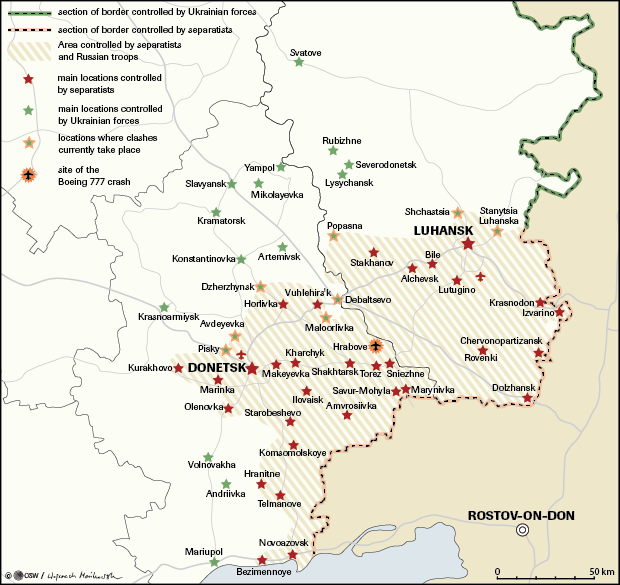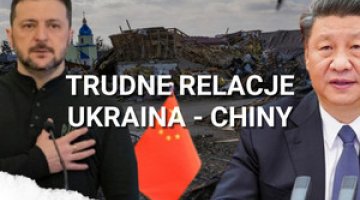Russia sabotages the Minsk agreement on the Donbas
On 31 January, this year’s first meeting of the Contact Group to resolve the conflict in the Donbas was held in Minsk; it included representatives from Ukraine, Russia, the OSCE and the breakaway Donetsk and Lugansk republics (the DPR and LPR). The negotiations took place simultaneously with the military offensive by separatist forces (supported by Russian units), which has been ongoing since mid-January. This offensive has brought about the collapse of the ceasefire which had been nominally in effect since 5 September 2014, and a return to the open phase of military action. In recent days, particularly fierce clashes have been taking place around Debaltseve, where the Ukrainian positions have driven a wedge into the separatist-controlled areas, and also north of Lugansk and west of Donetsk. The large-scale use of heavy artillery and armoured formations, together with the rising numbers of casualties, has raised the conflict to the same level of intensity as last summer.
During the discussions in Minsk, the separatists’ representatives rejected the OSCE’s project for a detailed plan to implement the Minsk agreements of 5 and 19 September last year, and demanded its revision. Leonid Kuchma, representing the Ukrainian side, said that during the negotiations the separatists had demanded that Kyiv should recognise the DPR and LPR’s recent territorial gains, and implement a unilateral ceasefire; otherwise they would resume full-scale hostilities.
The failure of the meeting resulted from a decision taken by Russia, which is supporting the separatists, to completely revise the Minsk agreements, which are unfavourable to it; and to impose a new plan on Ukraine that will give Moscow the lasting ability to influence the Ukrainian state by controlling events in the Donbas. Kyiv, with the West’s support, is unequivocally opposed to what is effectively a Russian ultimatum, recognising that the Minsk agreements still offer the basis for a peaceful resolution. The parties’ conflicting goals and expectations mean that we should expect further armed clashes, inspired by Russia, in the east of Ukraine. Another truce will only occur if Russia sees a chance of achieving its political goals through diplomatic channels, or if Ukrainian forces offer effective armed resistance and inflict serious losses among the Russian forces fighting in the Donbas.
Kyiv and the Minsk agreements
After the separatists’ representatives broke off negotiations within the Contact Group (no date for another meeting has yet been set), Kyiv managed to obtain an agreement from Germany and France (who are participating in the ‘Normandy format’ for a peaceful settlement in Donbas) that the Minsk agreement of September still applies. During a phone call on 1 February between Ukrainian President Petro Poroshenko, Chancellor Angela Merkel and President François Hollande, the leaders called for “a return to all points of the Minsk agreements without exception”, as these are the only basis for a peaceful settlement, as well as for “an immediate and unconditional ceasefire”.
Last September, in the face of an offensive by the separatists (backed by regular troops from the Russian army), Kyiv agreed to sign the agreements, within which it was nevertheless able to negotiate favourable provisions for itself. In addition to the ceasefire, the most important points of the document for Ukraine were the order for foreign forces and military equipment to be withdrawn; the creation of a 30-kilometre buffer zone separating the warring sides, and of a buffer zone along the Russian-Ukrainian border to be monitored by the OSCE. At the same time Kyiv committed to a decentralising reform process; to giving ‘special status’ to certain areas of the Donetsk and Lugansk oblasts; to organising local elections in the Donbas in accordance with Ukrainian laws; and to holding nationwide social dialogue and passing an amnesty law.
The Ukrainian government expected that the Minsk agreements would form the basis for a peace settlement and the region’s return to the legal authority of Ukraine. Importantly, Kyiv did not commit to give full autonomy to the Donbas, but only an unspecified ‘special status’. As early as 16 September, the Ukrainian parliament adopted a special law that would guarantee the region competence in the economic, fiscal and cultural spheres. However, the DPR and LPR effectively ignored these moves, and held their own elections to local authorities on 2 November; Russia also failed to honour the Minsk agreements. As a result, Kyiv took action to suspend financial transfers, and began to create a de facto border between the breakaway territories and the rest of Ukraine.
So why did Russia sign up for the Minsk agreements?
The agreements were signed in Minsk after 24 August, the date when Russia sent regular troops supporting the separatists’ counteroffensive into the territory of eastern Ukraine. As a result, the Ukrainian forces suffered heavy losses and were pushed away from Donetsk; and so the separatist formations, the so-called Donetsk and Lugansk People’s Republics, were saved from collapse and gained access to the Sea of Azov. Moscow thus demonstrated to Kyiv that the latter could not resolve the conflict in its favour by purely military means. Moscow therefore agreed to a truce as it had the tactical initiative and the military advantage.
It seems that there were two main reasons for Russia’s decision. Firstly, the Kremlin wanted to gain time to strengthen the separatist republics in Donbas politically and militarily, so that – formally – they could play a greater role in the political talks and assume the main burden of warfare in the future. Secondly, Moscow hoped that the Minsk agreements would start a process of fundamental negotiations and political agreement, even though Russia did not intend to honour any of their provisions which were most important for Ukraine. These agreements, in accordance with Moscow’s intentions, would lead to autonomy for the areas of the Donbas under separatist control, which was supposed to be part of a wider plan for the federalisation of Ukraine. For Moscow, the Donbas separatists were conceived as an instrument to prevent the future European integration of Ukraine and, if necessary, to destabilise the state. The agreements would also guarantee Ukraine remained a neutral state (blocking its possible future membership of NATO).
Additional factors lying behind Moscow’s decision probably included a reluctance to bear the rising costs, both human (during the August offensive, it is estimated that about 200 Russian soldiers were killed; despite the information blockade in Russia it proved impossible to keep the losses secret) and economic (after incurring the significant costs of annexing Crimea, Moscow did not want to take on the much larger costs of maintaining the separatist republics in the Donbas). The ad hoc ceasefire also coincided with the NATO summit in Newport, where decisions were taken on how to strengthen the eastern flank of the Alliance; and with discussions in the EU on tightening the sanctions against Russia, by providing arguments to those European politicians who had opposed such actions.
... and why has it sabotaged them?
The situation which arose after the Minsk ceasefire did not meet Russian expectations. Russia did supply political and military reinforcements to the separatist republics in the Donbas; they even held ‘presidential elections’, and their governments, with support from Russian special forces, have consolidated control over the separatists, neutralising or physically removing the most recalcitrant local warlords. Russia has strengthened the separatists’ forces with new supplies of military equipment, and has partially transferred its military training of these forces from the Rostov region (in the Russian Federation) onto the territory of the breakaway republics themselves. However, the political talks on resolving the crisis have stalled. The Ukrainian side and the West did not want to put up with the separatists’ and Russia’s failure to honour the ceasefire agreement. The ‘special status’ President Poroshenko offered the Donbas did not live up to the Kremlin’s expectations, as it would not allow Russia to influence the policy of Ukraine. Moreover, when Kyiv stopped financial transfers to the separatist areas of the Donbas, the threat arose that Moscow would be forced to actually take over their maintenance itself – and this in the face of the deteriorating economic situation within Russia itself.
In this situation, especially when the principled stance of Kyiv and Berlin led to the postponement of a summit on the Ukraine crisis in Astana, Russia came to the conclusion that only a re-escalation of hostilities could break the political stalemate and force both Ukraine and Germany (negotiating on behalf of the EU) to make political concessions. The so-called Putin plan (a terse letter from him to the Ukrainian president), which was presented shortly after the start of the separatists’ latest offensive in mid-January 2015, and the subsequent demands presented by Russian Foreign Minister Sergey Lavrov, left no doubt that Russia was effectively rejecting the terms of the Minsk agreements. Moscow demanded a de facto recognition of the separatists’ new territorial gains, a unilateral ceasefire and the withdrawal of heavy military equipment by the Ukrainian side, as well as a high degree of autonomy for the separatist Donbas within a framework of constitutional regulations that would ensure Russia’s influence on the policy of Ukraine (this included granting Ukrainian regions the right to pursue independent foreign economic policies, and to block the Kyiv government’s decisions on foreign and security policy).
The Kremlin decided that it could afford to take such radical action because it has probably come to the conclusion that the West is tired of the protracted Ukrainian crisis and is disappointed by Kyiv’s policy; and that the EU is having increasing difficulty in maintaining a consensus on its policy towards Russia, and is unable to decide on tightening economic sanctions. The statements and proposals put forward by some EU politicians have reinforced Moscow’s belief that the EU wants to seek a modus vivendi with Russia, and is more inclined to force Kyiv to make a political compromise with Moscow than to support Ukraine strongly in its resistance to Russian aggression.
What next?
The probable main objective of the current offensive by the separatists in the Donbas, with the support of Russian forces, is to expand the area under their control (the maximum variant, based on their previous declarations, would be to reach right up to the administrative borders of the Donetsk and Lugansk oblasts); and above all, to break the morale of the government, the armed forces, and also to an extent the wider Ukrainian society, by bringing the Ukrainian forces to local military defeat, resulting in significant loss of life. By forcing the Ukrainian authorities to finance a costly war, Russia is also working to bring about a deepening economic crisis in Ukraine; to make the reform process more difficult; and to complicate Kyiv’s talks with the IMF on a new bailout package. Systematically expanding the limits of the area under separatist control may also serve to prevent the EU introducing a visa-free regime for Ukrainian citizens. Moscow also wants to demonstrate that Kyiv cannot rely on arms supplies from Western countries. It seems that Russia is also hoping that Germany, which is negotiating on behalf of the EU, will fear an uncontrolled escalation of the conflict and its negative political and economic consequences for the EU, and will thus exert additional pressure on the Ukrainian authorities to reach a new political agreement with the separatists and Russia. If Moscow sees Berlin and Kyiv as being ready to conclude another agreement, which would clearly mark progress in implementing the policy objectives set out above, then it may agree to another ceasefire, but on different conditions from those set in Minsk – ones which would favour Russia. Thus, by using military, economic and diplomatic instruments, either in parallel or alternately, Russia intends to move closer to achieving its key goal: to subjugate Ukraine.
Map
Situation in eastern Ukraine (as of 4 February)






